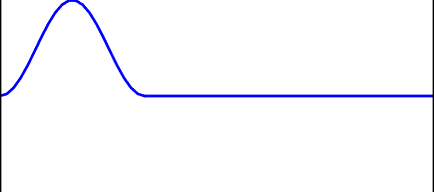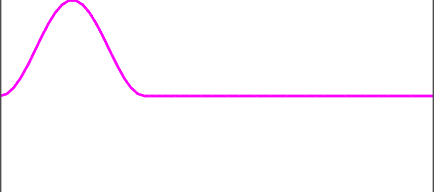All kinds of stringed instruments – guitars, pianos, violins – have stretched strings which oscillate when plucked or struck. This oscillation generates sound. The note depends on the frequency at which the string vibrates – and this depends on:
- The tension in the string.
- The length of the string.
- The mass per metre of the string (also known as mass per unit length).
This animation shows an impulse travelling along a string. When it meets a fixed point at one of the ends it is reflected back. Note, the wave flips when it reflects, it moves to the right as a hump, but to the left as a dip.

The end of the string has been solidly fixed at the end (imagine the black lines are the edges of a large metal block) to ensure a reflection of the wave when it meets this boundary. When the wave is reflected there is a phase change – if the displacement of the string is in an upwards direction for the wave travelling left-to-right, then the reflected wave going from right-to-left will be displaced in a downwards direction.
In the above animation the pulse keeps going forever, but that doesn’t happen in reality, a guitar string dies away. Below is more realistic. Compare the amplitude of the reflected wave and the incident wave – what does this tell you about the presence or absence of damping at the points of reflection? The damping causes the wave to get smaller as vibration energy turns to heat.

You can see this animation happening for real in this slow motion video of a transverse wave travelling along a bungee cord. Or if you prefer to see a real instrument, the video below that, is high speed footage of a guitar sting being plucked.
Making it louder
The string alone doesn’t create much audible sound, so the vibration has to be amplified. This could be done electronically, via a pick-up, amplifier and loudspeaker, as is done with an electric guitar. Alternatively, acoustic instruments use the vibration of thin pieces of wood. For a guitar, the top wood plate vibrates, for example. The video below shows how a violin body vibrates as it amplifies sound. The mode shapes are different for each frequency. In the video, tea leaves have been sprinkled onto the plate, and these shift to where the wood isn’t moving, and therefore shows the pretty vibration patterns.
The strings of a guitar and violin also have vibration modes created by standing waves.